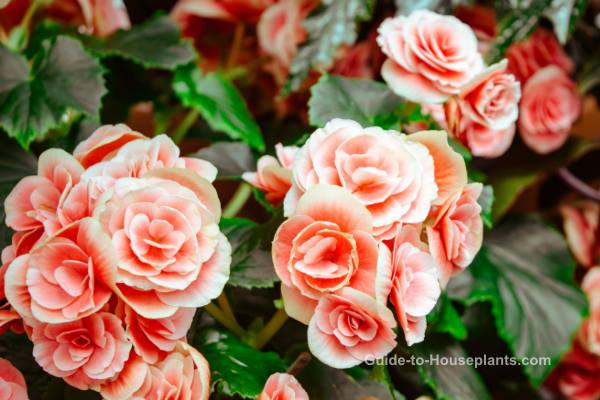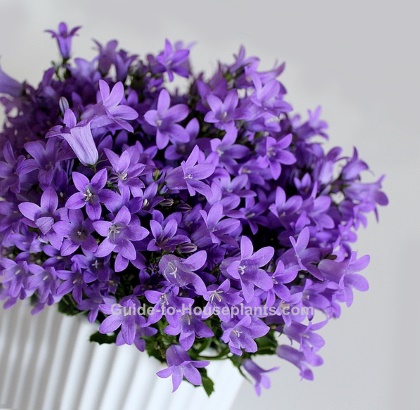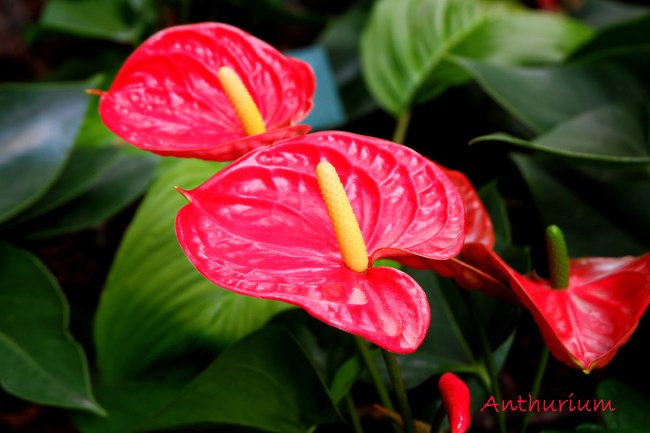Christmas Cactus Care
Botanical Name: Schlumbergera bridgesii
Good Christmas cactus care will bring a show of beautiful winter blooms year after year.
Discover how to prune, when to repot, how to propagate (it's easier than you think!), and get your holiday cactus to re-bloom next year. With this guide, I'll tell you how.
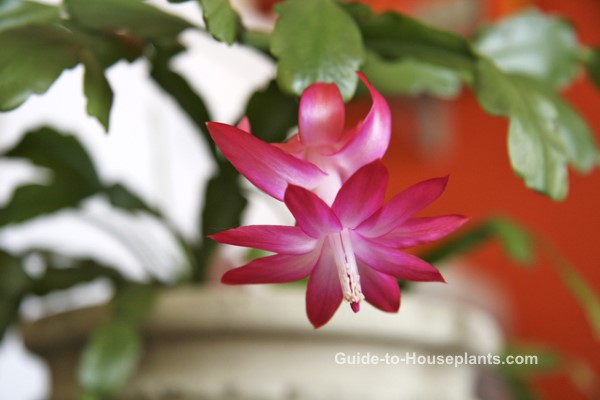 Christmas Cactus is a stellar performer with gorgeous blooms in time for the holidays.
Christmas Cactus is a stellar performer with gorgeous blooms in time for the holidays.Get to Know Your Christmas Cactus
Known botanically as Schlumbergera bridgesii, this tropical cactus does not exist in the wild. It is a hybrid of Schlumbergera truncata and Schlumbergera russelliana that grow as epiphytes in the rain forests of South America, making their home on tree branches. (Epiphyte comes from the Greek words epi meaning upon and phyton meaning plant.)
Schlumbergera bridgesii has dark-green flattened stems composed of segments joined in a scalloped pattern.
Flowers appear at the tips of the stems, about 2 in (5 cm) long. The flowers have stamens protruding from the back-swept petals, available in shades of pink, red, purple, yellow and white.
More than 200 cultivars exist. 'Christmas Flame' is golden yellow...'Lavender Beauty' is purple and white...and snowy 'White Christmas' are just a few. With so many captivating colors to choose from, why buy just one? Newer cultivars bring together two colors, offering some exciting new combinations.
Year-Round Christmas Cactus Care
What to Do After Flowering
After putting on a big show of blooms for the holiday season, this beauty needs a rest. When the flowering has stopped, water sparingly and stop fertilizing for about two months. Keep up the humidity. You can resume normal care when you see new growth, beginning in spring.
How to Prune and Propagate Christmas Cactus Cuttings
Wondering whether to prune? It's not mandatory, but this tropical cactus will eventually get "leggy" if you let it grow.
Regular pruning will encourage the plant to branch out where the stem was cut, creating a fuller plant. Because flowers grow at the ends of the stems, you'll also get more flowers this way. Spring is the best time to prune it back, when it begins actively growing again.
Pruning Tip: Use sharp, clean pruning shears to prevent tearing the stems. Cut a stem off between segments (the place where they're joined together by a midrib).
Don't toss out those stem cuttings! Propagate them for more plants. See "Propagation" below.
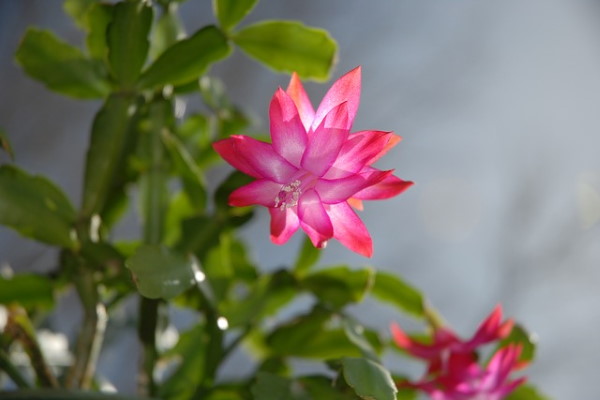 Christmas cactus care throughout the year will ensure an abundance of winter flowers.
Christmas cactus care throughout the year will ensure an abundance of winter flowers.How to Get Christmas Cactus to Bloom Again
Schlumbergera bridgesii is often coaxed into bloom by greenhouse growers to sell before the holidays. You can expect an abundance of colorful winter flowers every year without any special treatment, but they'll probably appear later in the season than when you bought your plant.
Want to coax it early? I thought so. There are a few things you should do to make it bloom before the holidays.
- Shorter, cooler days and nights for about 8-10 weeks are needed for the plant to set buds. Moving it outdoors in fall is ideal, just keep it out of direct sun. Bring the plant back inside before the first frost.
- Keep soil barely moist, but not too dry. Shriveled, limp stems are a sign that it's too dry.
- After you bring your plant indoors, keep it in a room that stays completely dark after sunset, giving the plant total darkness for 12-14 hours a night. Cover the cactus with a box or bag, if needed for this dark period each night.
- Once it starts budding, move your plant to a location where you want to display it for the season, and keep it there. Changes in light and temperature by moving it around will cause it to drop its buds and flowers. Also keep it away from drafty areas like doorways and heat vents.
Problems, Solutions and Answers
Dropped blooms? This holiday cactus will drop its flower buds when it's stressed from dry soil, low light, blasts of cold air from doorways or repotting while it's in bloom. Once buds set, don't move your plant around. Changes in light and temperature (besides nightly fluctuations) may cause blooms to fall off.
Wondering when to repot? Repotting Christmas cactus is usually only necessary every 2 to 3 years. Christmas cactus prefers to be slightly pot-bound and blooms best this way. Wait till spring or early summer to repot -- never while it's budding and blooming, which can cause them to drop. Use a heavy pot to balance the weight of an older, larger plant. Long stems can topple a lightweight pot. If you want to cover up a plain nursery pot, slip it into a cachepot -- a decorative container without drainage holes.
Wrinkled, drooping stems are typically a sign this plant is thirsty. Take care not to over-water, but don't allow the potting medium to dry out, either. Yellow stems indicate too much water. (See "Water" in the tips below.)
Is Christmas cactus poisonous? No. While it's not a good idea to allow your pet to chew on houseplants, you don't have to worry about this one. According to the ASPCA, it's safe for cats and dogs.
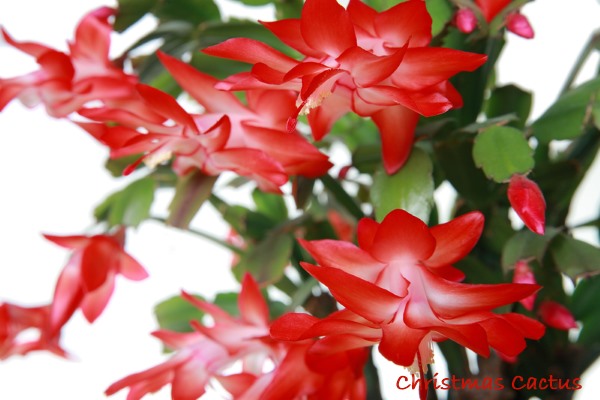 Vibrant red blooms adorn this Christmas Cactus, making it extra festive.
Vibrant red blooms adorn this Christmas Cactus, making it extra festive.Christmas Cactus Care Tips
Origin: Hybrid of Schlumbergera truncata and Schlumbergera russelliana, native to the Brazilian rain forest
Height: To 2 ft (60 cm)
Light: Christmas cactus care includes lots of bright, indirect light. This tropical cactus doesn't like hot, direct sunlight because it will burn the foliage. Stems that turn purplish-red have been exposed to too much direct sunlight.
Water: Water thoroughly, then empty the drainage tray. Allow the surface of the soil to dry before watering again. One thing this cactus won't tolerate is soggy soil, which can lead to root rot and possibly stem rot. Soft, mushy, or yellow stems are symptoms of over-watering. Don't allow the potting medium to dry out either -- stems will shrivel and wilt, and those buds and blooms may drop off, if gets too dry. After the flowering season is over, water sparingly until new growth begins in spring.
Humidity: Try to maintain around 50% relative humidity near the plant. Indoor air can become extremely dry in the winter, so it's a good idea to use a humidity gauge, rather than guess. Keep tropical plants away from heat vents and fireplaces. Stand the pot on a dish of wet pebbles or use a cool-mist room humidifier, if needed. Check out these tips for raising the humidity.
Temperature: To set flower buds, the plant needs cool 60-65°F/16-18°C days and 45-55°F/7-13°C nights. Once buds set, 70-75°F/21-24°C days and 60-70°F/16-21°C nights.
Soil: Well-drained potting medium is essential. Mix 1 part peat moss-based potting mix and 1 part fine-grade fir bark.
Fertilizer: Feed every 2 weeks spring through fall with a water-soluble fertilizer that includes micro-nutrients. Don't skip this -- regular feeding will give your plant more oomph for blooming.
Propagation: Christmas cactus cuttings can be propagated for more plants. In spring, take stem cuttings of 2-3 segments. Allow the cut ends to dry for a day or two, then place cut end upright in moist perlite or peat moss-based mix.
